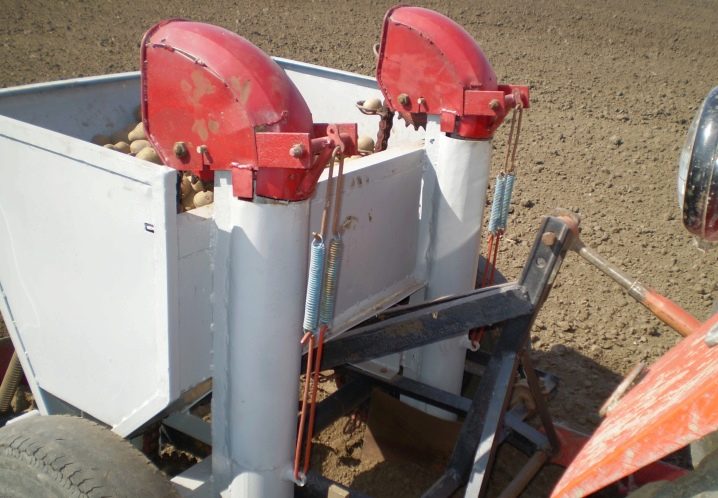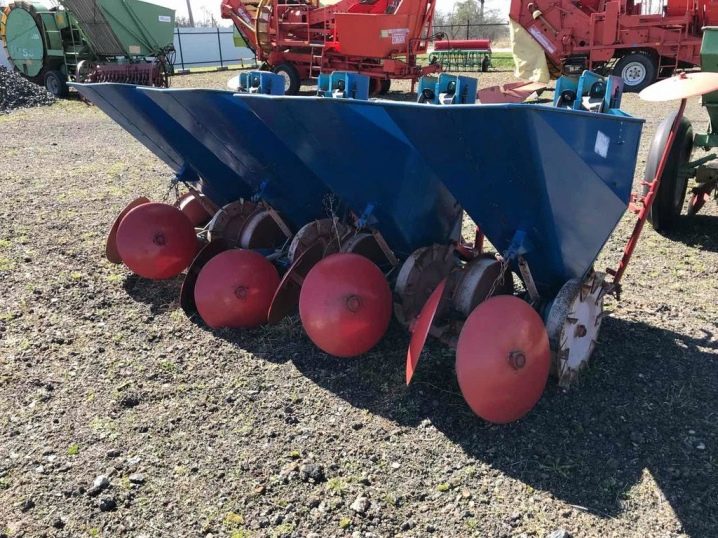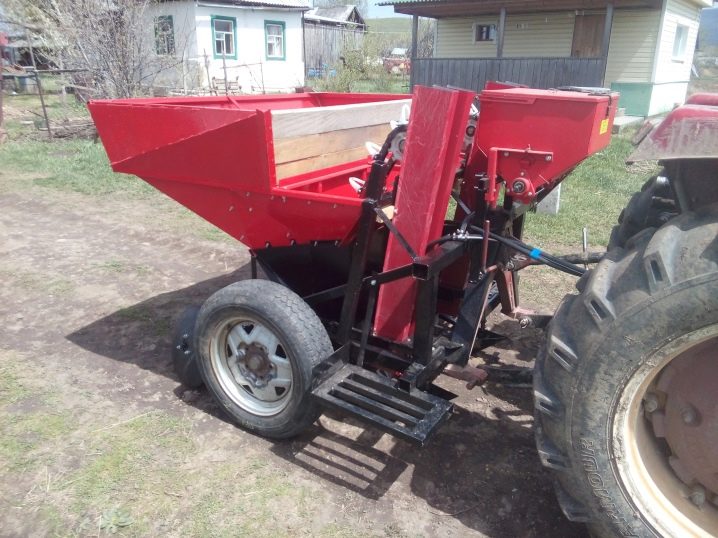Making planters for a walk-behind tractor with your own hands

Planting potatoes has always been considered labor-intensive and difficult work. But now, owing to the progress of technology, agricultural work has been significantly facilitated. Today, due to motoblocks, mini-tractors and additional equipment to them, it has become possible to improve the cultivation of the land, get a better harvest and reduce the cost of production.

Among farmers and owners of small plots of land, motoblocks are in great demand, which can be equipped with mounted agricultural implements, including a potato planter.

Types of potato planters
There are several varieties of potato planters on the market, differing in configuration, dimensions and functionality. The cost of such devices is also different.

You can buy both expensive universal modifications and affordable budget mechanisms.
Compact
Small planters are used for planting seed potatoes on a plot of land or in a vegetable garden in the country. The structure of the device includes a regulator of the planting depth of seeds and a controller of the height of the soil comb, which is formed due to the raising of the soil. Compact potato planters can be used with motor vehicles of both Russian and foreign manufacturers.

The mass of such devices is approximately equal to 20-25 kilograms. The hopper capacity is up to 34 liters. With a potato planter, you can cultivate rows 60–75 centimeters wide and plant 5–6 tubers per meter. The planting rate is within 0.2 hectares / hour.

Average
Such potato planters have a capacious tank with a volume of 44 liters. These are rather bulky and difficult planters, their weight is 41 kilograms, and their productivity is 0.2-0.25 ha / h. Such devices are aggregated with small and medium motor vehicles.

Large
Practiced to cultivate significant land areas. They have a large-sized hopper, into which potatoes are loaded by means of a dump truck. Joins the tractor. These are powerful, expensive structures used in private farmsteads and large agricultural enterprises. Such tools can be aggregated, rather, with medium and heavy equipment, but not with manual walk-behind tractors. And you can practice as a stand-alone unit.

Potato planter design
Due to their versatility, devices for planting potatoes are suitable for various types of walk-behind tractors and include the following elements.
- Capacity or hopper for feeding seed potatoes. The device is mounted to a frame welded from a corner or a shaped tube.

- Iron base (chassis). Wheels with high tread are fixed to the chassis. It resists slipping and prevents motor vehicles from overheating. On the wheel axle there is a sprocket for the chain hoist.
- Chain hoist. With its assistance, an inflow of tubers from the bunker is produced for the subsequent movement of tubers into a vertical pipe, from which they fall into the formed furrow.

- Plow. It is used to cut furrows in the soil.
- Hilling tool. With its help, potato tubers planted in the soil are covered over with soil.

This is a mandatory minimum of components in order to make a homemade potato planting device. Individual craftsmen are trying to improve this attachment by adding a fertilizer reservoir or trying to increase productivity, they mount 2 planting modules.

As a result, all this leads to an increase in the mass of the unit, as well as, of course, to an increase in the load on the walk-behind tractor and a decrease in its efficiency. As a result, it is reasonable to select the design and materials in strict accordance with the power of the technology.
Tools and materials
To make a potato planter with your own hands, you will need a considerable set of tools and parts. Let's consider this completeness.
- Axles, a chain from a bicycle (or a chain from a motor vehicle), bearings for wheels and creating a chain hoist.

- Iron sheet for the construction of the loading tank.
- Iron profile with a round or square section - for mounting the holder frame and other purposes.
- Welding equipment for the reliable connection of the potato planter components to each other.

- Electrodes of various capacities for welding.
- Angle grinder and discs for cutting iron sheet into suitable parts.

- Electric drill and drills for it for drilling.
- Mounting parts for the reliability of the device.
- Nuts and bolts for mounting the structure.

- Several meters of wire for fixing individual parts of the device.
- Sandpaper or file for grinding and cleaning elements.

First, it is necessary to make all the drawings (can be found in special literature or on the Internet), carefully study them, think over the dimensions of the future device and its appearance, the method of fixation to motor vehicles. The dimensions of the potato planter should not be very large so that the device turns out in accordance with the available motor equipment.

The capacity of the container for filling the tubers is set based on the calculation of the double bed length. The volume of the hopper should be enough for the walk-behind tractor to pass two furrows with a filled container and return to the secondary loading post.
Planter making process
A homemade planter, by and large, is a trolley on wheels connected to motor vehicles. It is only at first glance that the design of the potato planting unit looks uncomplicated, but there are certain nuances in it. The planter for motoblocks is installed on a frame made of 8-mm channel sections with two spars located enfilade, coupled with three crossbars. In the front area of the chassis there is an arch with a fork for attaching to the central link. On the edges of the frame, there are covering disc stands and plate supports for the seed feeder.

The wheelbase includes 2 lug wheels. Between the wheels there is a disc made of wood 60 millimeters thick with 4 proportionally placed semicircular passages, the dimensions of which should make it possible to capture even large tubers. In addition, instead of wheels with grooves, a structure of gears, a chain and tubers placed on it can be used for planting potatoes.

There is another significant component of the design - this is the hopper, which is located above the wheels. You will need a 3mm sheet of iron to create the hopper. The narrow neck and bottom of the container must be covered with rubber to prevent damage to root crops.
The grooved wheel should be covered with a specialized shield, which will prevent the potatoes from falling out on their own until the required moment they hit the ground.

The grooved wheel should be covered with a specialized shield that will prevent the potatoes from falling out on their own until the required moment of their falling into the ground.
The frame of an artisanal potato planter must be secured with iron strips, which must be positioned from the central crossbar to the arch. In addition, it is necessary to weld auxiliary corners and metal pads, the thickness of which should be approximately at least 4 millimeters.

Seeder seat and axle
We fix a footrest made of a 5 mm iron sheet to the side members. The height of the footboard should be designed to suit the height of the planter and in such a way that the potato planter is easy to use.

The seat is made of 45x45x4 mm iron corner. Planks are fixed on the frame, which are covered with foam rubber and covered with a leather substitute or durable fabric. For maximum comfort, you can use an old car seat purchased at a car disassembly. It should be noted, of course, that the bulk of potato planters are made without a seat. But it all depends on the area of planting, the quality of the soil and the speed of the unit. Running on wet or loose ground behind a fast moving planter is not up to every athlete.

A wheel axle and a holder for fixing the rippers are fixed under the chassis. For the axle, a thick-walled steel pipe is used, at both ends of which there are spikes. They are turned on turning equipment and fixed by means of steel pins.

Wheels
The wheels for the artisan planter must be equipped with specialized lugs. It is recommended to take any wheels from agricultural machinery. If only they fit in size.
On the hubs that hold the wheels, there should be 2 bearings each, protected from dirt and dust by stuffing from a felt mat. The axle is mounted to the chassis using two steel plates and four bolts or welded angles.

Rippers
For the holder of the rippers, an iron rod is used, at the ends of which clips are mounted that hold the legs of the paws. The bar is made of an iron corner with a size of 50x50x5 millimeters, but it is advisable to use a profile pipe with a square section for reliability. The clips are made of 5mm iron plates.

Sower
To make a sower, you will need a metal or cast iron pipe 10 cm in diameter and a wall thickness of at least 3 mm. From the bottom to the pipe, a furrow-maker is cooked, which is made of a 6-millimeter sheet of iron. To adjust the depth of entry into the soil of the furrower, it is enough to release the ladders and adjust its position by means of vertical displacements of the seed tube along the length of the frame supports. After adjusting the depth of the furrow-makers, the fasteners of the step-ladders must certainly be tightened securely, otherwise the seed tube, due to the large loads of the soil on the furrow-makers, have every chance to turn around in the process of work.

In the role of sealing discs, you can use discs from a model SO-4,2 seeder with the installation of two bearings instead of one. To do this, on each disc, it is required to bore the hub to a specific size. Bearings must be installed with their closed side outward to prevent dust and dirt from entering.

The planter is ready.
Making a garlic planter
To create a garlic seeder for a walk-behind tractor, you will need:
- wooden planks (iron - excess weight for the unit, which is undesirable);
- brush wheel (works by means of a chain drive);
- a shaft with a chain, mated with the front wheels of the walk-behind tractor;
- metal plates;
- product drawing.
From the boards, it is necessary to arrange a box according to the drawings, which will later become a bunker. A wheel with seeds is placed behind the box. It can be adjusted to the diameter of the bulb. An iron plate is fixed to the bottom of the planter frame, which plows the soil under the ridges. The plate opens up the furrows for planting the garlic. This type of planter can be considered multipurpose. Homemade garlic planter for motor vehicles is quick and easy to assemble.

How to make a do-it-yourself potato planter for a walk-behind tractor, you will learn from the video below.



































































The comment was sent successfully.